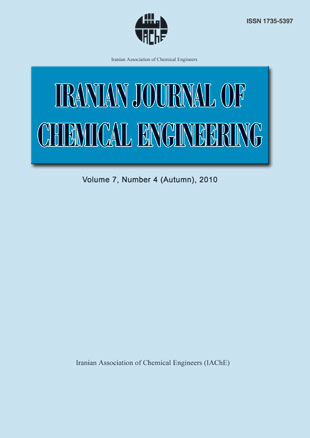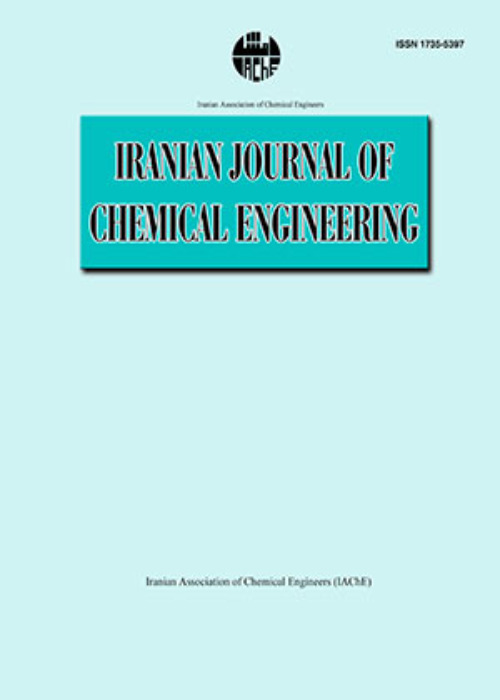فهرست مطالب

Iranian journal of chemical engineering
Volume:7 Issue: 4, Autumn 2010
- تاریخ انتشار: 1389/08/01
- تعداد عناوین: 8
-
-
Page 3Mass transfer coefficients of rising drops in spray and packed columns with randomand structured packing in a liquid-liquid extraction operation were experimentallymeasured and the results compared. In this work, a high interfacial tension chemicalsystem of toluene-acetic acid-water in a structured packed column is investigated.Results of random and structured packing show that random types are effective only fora drop size less than 9 mm, while the structured ones are shown to have a positive effecton mass transfer coefficient in a wide drop size range. Furthermore, structured packingproved to be slightly more effective than random packing in improving the masstransfer coefficient. The effect of drop size on mass transfer coefficient has also beenstudied in this work and the results showed that when the drop diameter increases, themass transfer coefficient increases too. Finally, new correlations for the prediction ofthe mass transfer coefficient in both a random and structured packed column have beenintroduced which are in better agreement with the experimental data in comparisonwith those resulted from Newman, Kronig-Brink and Handlos-Baron models.
-
Page 12In this work, the equation of state-excess Gibbs energy (EoS-GE) model has beenemployed to predict Liquid-Liquid Equilibria (LLE) of some binary mixtures at 0.1MPa. Three binary systems containing Decane+Methanol, Cyclohexane+Methanol andCyclohexane+2,2,2-Trifluoroethanol (TFE) have been tested using Peng–Robinson EoSmodified by Stryjek and Vera (PRSV), along with the excess Gibbs mixing rules MHV1and MHV2 and two excess Gibbs models: Wilson equation modified by Tsuboka andKatayama (T–K–Wilson) and UNIQUAC equation. The interaction parameters of T-KWilsonand UNIQUAC GE models for three binary systems have been determined fromLLE data points at 0.1 MPa. The prediction ability of the models has been evaluated bycomparison of the results with experimental data. Average Absolute Error (AAE) of0.047 for MHV1 and T–K–Wilson model, 0.0117 for MHV2 and T–K–Wilson model,0.0317 for MHV1 and UNIQUAC model and 0.0109 for MHV2 and UNIQUAC modelhave been obtained. As it is clear, the combination of MHV2 excess Gibbs mixing rulewith UNIQUAC equation shows a satisfactory agreement with experimental data.
-
Page 22The separation of immiscible liquids is an important process in oil and petrochemicalindustries. In the outlet stream of a catalytic reactor of dehydrogenation of ethylbenzene to styrene monomer, water is present because it is used as a high pressuresteam to provide reaction heat. Therefore, aqueous and immiscible organic phasesshould be separated in a horizontal separator before fractionation. The aim of thiswork is to study the batch separation of ethyl benzene and styrene from water. Differentmixtures of water, styrene and ethyl benzene were prepared using different amounts oforganic compounds and various mixing rates. The experiments show that theseparation time of ethyl benzene and water mixtures are more than that for styrene andwater mixtures. Furthermore, increasing the mixing rate increases the separation timebecause the dispersity of the system increases, but it has more effects on water/ethylbenzene mixtures.
-
Page 29Stuck pipe is one of the most serious drilling problems, estimated to cost the petroleumindustry hundreds of millions of dollars annually. One way to avoid stuck pipe risks isto predict the stuck pipe with the available drilling parameters which can be employedto modify drilling variables. In this work, Artificial Neural Network (ANN) was used forstuck pipe prediction according to the fact that this method is applicable whenrelationships of parameters are too complicated. Based on the drilling fluid conditionfrom one of the Iranian oil fields, stuck pipe instances were divided into static anddynamic types. The results of this study show more than 90% accuracy for stuck pipeprediction in the investigated oilfield. The methodology presented in this paper enablesthe Iranian drilling industry to estimate the risk of stuck pipe occurrenc during the wellplanning procedure.
-
Page 42Ibuprofen solubility in supercritical carbon dioxide was measured using a dynamicapparatus at a pressure between 80 and 140 bars at three different temperatures,308.15, 313.15 and 318.15 K. The mole fraction of Ibuprofen in fluid phase was in therange of 0.015 × 10-3 - 3.261 × 10-3 at the mentioned operational condition. ModifiedMendez-Santiago and Teja equation were used to check the consistency of theexperimental data. Results were correlated using the Stryjek and Vera equation of statewith the van der Waals 1-parameter (vdW1) and 2-parameters (vdW2) mixing andcombining rules. Interaction parameters along with the percentage of the averageabsolute relative deviation (%AARD) were displayed. Also, the Lydersen groupcontribution methods were used for predicting the physicochemical and criticalproperties of the Ibuprofen.
-
Page 50In this contribution Artificial Neural Network (ANN) modeling of the hydrocrackingprocess is presented. The input–output data for the training and simulation phases ofthe network were obtained from the Tehran refinery ISOMAX unit. Different networkdesigns were developed and their abilities were compared. Backpropagation, Elmanand RBF networks were used for modeling and simulation of the hydrocracking unit.The residual error (root mean squared difference), correlation coefficient and run timewere used as the criteria for judging the best network. The Backpropagation modelproved to be the best amongst the models considered. The trained networks predictedthe yields of products of the ISOMAX unit (diesel, kerosene, light naphtha and heavynaphtha) with good accuracy. The residual error (root mean squared difference)between the model predictions and plant data indicated that the validated model couldbe reliably used to simulate the ISOMAX unit. A four-lumped kinetic model was alsodeveloped and the kinetic parameters were optimized utilizing the plant data. The resultof the best ANN model was compared to the result of the kinetic model. The root meansquare values for the kinetic model were slightly better than the ANN model but theANN models are more versatile and more practical tools in such applications as faultdiagnosis and pattern recognition.
-
Page 64This paper reports a study to find optimum conditions for oil extraction from vetiverroot. For this purpose, the influence of temperature and pressure on the extraction yieldis investigated. In addition, the effects of supercritical fluid flow rate and particlediameter on optimum temperature and pressure have been studied. The results showthat optimum pressure is a strong function of particle diameter and solvent flow rate.However, the results reveal that the optimum temperature is independent from particlediameter and solvent flow rate.
-
Page 71


